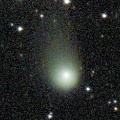
|
Now it is bright as 9.7 mag (June 1, Osamu Miyazaki). The brightness evolution is slower than originally expected. It is expected to be observable at 7.5-8 mag for a long time from 2022 to 2023. In the Northern Hemisphere, it stays observable in good condition until autumn. However, it is not observable at the high light from autumn to 2023 summer. In the Southern Hemisphere, it stays observable in good condition for a long time.
Date(TT) R.A. (2000) Decl. Delta r Elong. m1 Best Time(A, h)
June 4 18 17.44 9 1.4 2.144 3.005 141 9.2 1:30 ( 0, 64)
June 11 18 5.76 7 41.1 2.040 2.943 146 9.1 0:51 ( 0, 63)
|
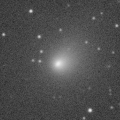
|
Now it is very bright as 9.4 mag (May 29, Marco Goiato). It stays bright as 9-10 mag from spring to summer. In the Southen Hemisphere, it stays observable in good condition for a long time after this. In the Northern Hemisphere, it is not observable until November when it fades down to 14 mag.
Date(TT) R.A. (2000) Decl. Delta r Elong. m1 Best Time(A, h)
June 4 2 15.87 -81 16.8 1.219 1.780 105 9.3 3:02 (349,-35)
June 11 6 16.74 -79 4.7 1.256 1.777 102 9.4 20:59 ( 13,-40)
|

|
Appearing in the evening sky. Now it is very bright as 8.4 mag (May 31, Carlos Labordena). It is brighter than originally predicted by 3 mag. The condition is very bad in this apparition. It is observable only in the extremely low sky from mid May to mid July in the Northern Hemisphere, or from early June to early August in the Southern Hemisphere.
Date(TT) R.A. (2000) Decl. Delta r Elong. m1 Best Time(A, h)
June 4 7 2.75 24 34.7 1.629 0.925 31 10.2 20:54 (116, 6)
June 11 7 41.36 23 38.5 1.704 1.023 33 11.2 20:59 (114, 7)
|
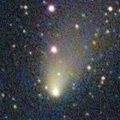
|
Now it is bright as 11.4 mag (May 28, Osamu Miyazaki). It is expected to brighten up to 9-10 mag in summer. But it is not observable around the high light. In the Northern Hemisphere, it is observable only until June. In the Souther Hemisphere, it is not observable until October.
Date(TT) R.A. (2000) Decl. Delta r Elong. m1 Best Time(A, h)
June 4 6 38.47 53 14.8 2.074 1.411 37 11.1 20:54 (142, 19)
June 11 7 13.20 49 57.4 2.036 1.344 35 10.8 20:59 (139, 17)
|

|
Now it is 10.1 mag (May 28, Osamu Miyazaki). It will be getting lower after this. In the Northern Hemisphere, it will be unobservable soon. In the Southern Hemisphere, it stays observable until July.
Date(TT) R.A. (2000) Decl. Delta r Elong. m1 Best Time(A, h)
June 4 7 35.62 8 35.3 4.473 3.792 42 10.9 20:54 ( 98, 3)
June 11 7 42.79 7 40.3 4.555 3.814 38 11.0 20:59 (101, -3)
|
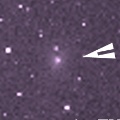
|
Now it is 11.1 mag (May 21, Thomas Lehmann). It will be fading gradually after this. It will be getting higher after this also in the Northern Hemisphere.
Date(TT) R.A. (2000) Decl. Delta r Elong. m1 Best Time(A, h)
June 4 0 13.92 -0 53.9 1.795 1.738 70 11.6 3:02 (285, 19)
June 11 0 27.35 0 12.0 1.768 1.770 73 11.7 2:59 (286, 22)
|

|
Now it is bright as 12.0 mag (May 28, Osamu Miyazaki). It stays observable at 11-12 mag until July.
Date(TT) R.A. (2000) Decl. Delta r Elong. m1 Best Time(A, h)
June 4 11 49.62 -8 14.4 3.824 4.243 107 11.7 20:54 ( 38, 39)
June 11 11 52.59 -7 15.8 3.924 4.242 101 11.8 20:59 ( 46, 36)
|
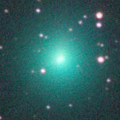
|
It brightened very rapidly up to 9.3 mag in March (Mar. 24, Michael Jager). In the Southern Hemisphere, it is appearing in the morning sky. It stays observable in good condition after this. In the Northern Hemisphere, it will never be observable again.
Date(TT) R.A. (2000) Decl. Delta r Elong. m1 Best Time(A, h)
June 4 2 55.77 -3 42.4 2.046 1.388 37 12.4 3:02 (263,-15)
June 11 3 7.27 -7 25.4 2.021 1.466 43 12.8 2:59 (268,-15)
|

|
Now it is 13.6 mag (May 26, Jose Guilherme de S. Aguiar). It will brighten up to 12.5 mag in summer. In the Southern Hemisphere, it stays observable in excellent condition for a long time. In the Northern Hemisphere, it is not observable until August.
Date(TT) R.A. (2000) Decl. Delta r Elong. m1 Best Time(A, h)
June 4 21 58.58 -61 14.5 2.563 3.133 115 13.0 3:02 (345,-10)
June 11 21 35.47 -62 37.6 2.454 3.111 121 12.9 2:59 (351, -9)
|

|
Now it is 13.2 mag (May 4, Thomas Lehmann). It stays 12-13 mag for a while. It is observable in excellent condition in the Southern Hemisphere. It locates somewhat low in the Northern Hemisphere.
Date(TT) R.A. (2000) Decl. Delta r Elong. m1 Best Time(A, h)
June 4 22 42.71 -20 6.2 1.317 1.776 98 12.9 3:02 (316, 21)
June 11 22 52.26 -20 14.1 1.287 1.808 102 13.0 2:59 (320, 23)
|

|
Now it is 14.2 mag (May 4, Thomas Lehmann). It will brighten up to 13 mag in summer.
Date(TT) R.A. (2000) Decl. Delta r Elong. m1 Best Time(A, h)
June 4 19 6.44 -29 52.4 2.137 3.044 147 13.4 2:19 ( 0, 25)
June 11 19 3.11 -30 22.1 2.092 3.043 154 13.3 1:48 ( 0, 25)
|
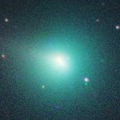
|
It brightened up to 8.8 mag from winter to early spring (Jan. 31, Chris Wyatt). Now it is fading. It has already faded down to 13.4 mag (May 14, ATLAS-MLO, Mauna Loa). It locates extremely low in the Southern Hemisphere. It will be unobservable in August in the Northern Hemisphere.
Date(TT) R.A. (2000) Decl. Delta r Elong. m1 Best Time(A, h)
June 4 8 18.88 41 25.1 2.421 1.899 48 13.5 20:54 (123, 28)
June 11 8 40.95 40 27.0 2.509 1.951 46 13.7 20:59 (122, 26)
|
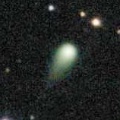
|
Now it is 13.4 mag (May 18, Masayoshi Yoshimi). It is expected to brighten up to 10 mag in 2023. In the Northern Hemisphere, it stays observable in good condition until 2023 autumn. In the Southern Hemipshere, it stays unobservable until 2023 summer.
Date(TT) R.A. (2000) Decl. Delta r Elong. m1 Best Time(A, h)
June 4 9 55.59 58 3.8 4.583 4.246 64 13.6 20:54 (140, 46)
June 11 9 53.27 57 21.1 4.608 4.189 59 13.5 20:59 (139, 41)
|

|
Now it is 14.1 mag (May 27, Katsumi Yoshimoto). It is expected to brighten up to 12 mag in 2023. In the Northern Hemisphere, it stays observable in good condition for a long time. In the Southern Hemisphere, it locates extremely low in 2022, but it will be observable in good condition in 2023.
Date(TT) R.A. (2000) Decl. Delta r Elong. m1 Best Time(A, h)
June 4 14 21.13 41 30.8 4.074 4.489 107 13.7 21:29 (180, 84)
June 11 14 10.11 40 21.6 4.109 4.454 103 13.7 20:59 (162, 85)
|
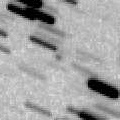
|
It is expected to brighten up to 13.5 mag in early summer. In the Southern Hemisphere, it is appearing in the morning sky. It stays observable in good condition after this. In the Northern Hemisphere, it is not observable at all.
Date(TT) R.A. (2000) Decl. Delta r Elong. m1 Best Time(A, h)
June 4 3 28.03 -27 32.3 1.552 1.249 53 13.9 3:02 (282,-34)
June 11 3 53.27 -32 36.3 1.418 1.249 59 13.7 2:59 (287,-36)
|

|
Now it is 13.6 mag (May 31, Toshihiko Ikemura, Hirohisa Sato). It is observable at 13 mag in good condition until early summer.
Date(TT) R.A. (2000) Decl. Delta r Elong. m1 Best Time(A, h)
June 4 10 19.77 11 52.4 2.168 2.218 79 13.8 20:54 ( 76, 38)
June 11 10 30.02 10 41.3 2.236 2.212 75 13.9 20:59 ( 79, 33)
|
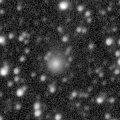
|
Now it is 14.3 mag (May 6, Chris Wyatt). It is expected to brighten up to 11 mag in 2023. In the Northern Hemisphere, it stays observable in good condition until November. But it becomes unobservable after that. In the Southern Hemisphere, it stays observable in good condition after this.
Date(TT) R.A. (2000) Decl. Delta r Elong. m1 Best Time(A, h)
June 4 18 36.80 18 13.1 3.704 4.440 131 14.0 1:49 ( 0, 73)
June 11 18 29.90 17 38.8 3.613 4.395 135 13.9 1:15 ( 0, 73)
|
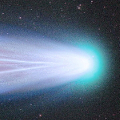
|
It brightened up to 3 mag from mid December to late December. Now it is fading. It has already faded down to 12.2 mag (Apr. 2, Thomas Lehmann). It is observable in good condition in the Southern Hemisphere. It is getting observable again also in the Northern Hemisphere.
Date(TT) R.A. (2000) Decl. Delta r Elong. m1 Best Time(A, h)
June 4 18 7.34 -37 55.3 1.688 2.650 156 13.9 1:21 ( 0, 17)
June 11 17 41.01 -36 37.9 1.747 2.741 165 14.1 0:27 ( 0, 18)
|

|
Now it is 17.6 mag (May 10, W. Hasubick). It will brighten rapidly, and it will brighten up to 12 mag from June to July. It stays observable in the morning sky until June.
Date(TT) R.A. (2000) Decl. Delta r Elong. m1 Best Time(A, h)
June 4 1 13.37 13 59.3 1.051 0.891 51 14.9 3:02 (264, 16)
June 11 2 1.67 16 34.2 1.054 0.807 45 14.1 2:59 (258, 12)
|

|
Now it is not observable. It will be observable again in August.
Date(TT) R.A. (2000) Decl. Delta r Elong. m1 Best Time(A, h)
June 4 5 26.79 29 13.4 6.983 5.991 11 14.1 20:54 (134, -7)
June 11 5 33.05 29 14.4 6.999 5.994 7 14.1 20:59 (138,-11)
|
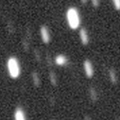
|
Now it is 14.5 mag (May 31, Toshihiko Ikemura, Hirohisa Sato). It will approach to Earth down to 0.29 a.u. in 2023 February, and it is expected to brighten up to 5 mag. In the Northern Hemisphere, it stays observable in excellent condition. In the Southern Hemisphere, it becomes unobservable from late September to early February.
Date(TT) R.A. (2000) Decl. Delta r Elong. m1 Best Time(A, h)
June 4 19 51.17 23 24.5 2.716 3.288 115 14.3 3:02 (358, 78)
June 11 19 41.42 25 41.3 2.584 3.212 119 14.1 2:26 ( 0, 81)
|
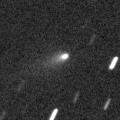
|
Now it is 15.1 mag (May 30, Michael Jager). It is expected to brighten up to 11-12 mag from summer to autumn. It stays observable in good condition in the Southern Hemisphere. In the Northern Hemisphere, it becomes extremely low from August to September.
Date(TT) R.A. (2000) Decl. Delta r Elong. m1 Best Time(A, h)
June 4 10 11.11 22 24.6 1.396 1.481 73 14.8 20:54 ( 89, 42)
June 11 10 21.91 20 32.1 1.389 1.418 70 14.5 20:59 ( 90, 37)
|

|
Now it is 14.9 mag (May 6, Chris Wyatt). It was expected to brighten up to 13 mag in spring. But actually, it is fainter than originally expected. In the Southern Hemisphere, it stays observable in good condition for a long time. In the Northern Hemisphere, it is not observable until autumn.
Date(TT) R.A. (2000) Decl. Delta r Elong. m1 Best Time(A, h)
June 4 6 31.27 -42 37.4 3.346 3.135 69 14.7 20:54 ( 59,-35)
June 11 6 33.11 -41 30.8 3.387 3.133 67 14.8 20:59 ( 62,-41)
|

|
Now it is 15.7 mag (May 1, Thomas Lehmann). It stays at 15-16 mag for a long time. In the Southern Hemisphere, it stays observable in excellent condition for a long time. In the Northern Hemiphere, it locates extremely low in spring.
Date(TT) R.A. (2000) Decl. Delta r Elong. m1 Best Time(A, h)
June 4 15 39.14 -50 44.2 4.360 5.253 148 14.9 22:47 ( 0, 4)
June 11 15 26.67 -50 53.1 4.405 5.270 145 14.9 22:07 ( 0, 4)
|

|
Now it is not observable. It will appear in the morning sky in September in the Northern Hemisphere, or in November in the Southern Hemisphere. It will brighten up to 11.5 mag in winter
Date(TT) R.A. (2000) Decl. Delta r Elong. m1 Best Time(A, h)
June 4 5 40.26 21 43.3 3.374 2.394 12 15.4 20:54 (126,-10)
June 11 5 54.37 21 51.9 3.350 2.352 9 15.2 20:59 (129,-13)
|
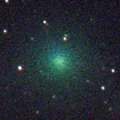
|
It was expected to brighten up to 4 mag, but it faded rapidly around the perihelion passage. It has already faded down to 14.6 mag (May 27, Katsumi Yoshimoto). It stays observable in good condition after this while the comet will be fading. In the Southern Hemisphere, it is not observable until August.
Date(TT) R.A. (2000) Decl. Delta r Elong. m1 Best Time(A, h)
June 4 12 23.28 78 13.0 0.920 1.151 72 15.6 20:54 (174, 47)
June 11 13 31.16 72 42.5 1.045 1.286 77 16.4 20:59 (174, 52)
|

|
It brightened up to 12.3 mag from spring to summer in 2021 (June 15, 2021, Marco Goiato). Now it is fading. It has already faded down to 15.8 mag (May 31, Toshihiko Ikemura, Hirohisa Sato).
Date(TT) R.A. (2000) Decl. Delta r Elong. m1 Best Time(A, h)
June 4 12 9.50 31 51.4 4.818 4.999 94 15.7 20:54 ( 88, 70)
June 11 12 5.95 31 44.2 4.976 5.043 87 15.8 20:59 ( 92, 62)
|

|
It approached to Sun down to 0.14 a.u. on May 15. But it was not observable around that time. Appearing in the morning sky. In the Northern Hemisphere, it stays observable at 17-18 mag in good condition from July to November. In the Southern Hemisphere, it stays extremely low.
Date(TT) R.A. (2000) Decl. Delta r Elong. m1 Best Time(A, h)
June 4 2 46.04 26 59.3 1.323 0.635 27 15.7 3:02 (240, 5)
June 11 2 56.22 29 1.1 1.436 0.783 31 16.2 2:59 (240, 9)
|
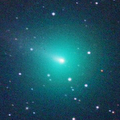
|
It brightened very rapidly up to 9.2 mag in winter (Jan. 31, Chris Wyatt). Now it is fading. It has already faded down to 14.7 mag (May 3, Chris Wyatt). It will be fainter than 18 mag in July.
Date(TT) R.A. (2000) Decl. Delta r Elong. m1 Best Time(A, h)
June 4 9 48.99 10 0.9 2.073 2.024 72 16.0 20:54 ( 80, 31)
June 11 10 3.03 9 2.6 2.201 2.083 69 16.5 20:59 ( 82, 27)
|
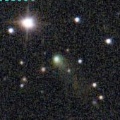
|
Now it is 15.9 mag (May 15, Thomas Lehmann). It stays observable at 16 mag from 2021 to 2022. It locates low in the Southern Hemisphere.
Date(TT) R.A. (2000) Decl. Delta r Elong. m1 Best Time(A, h)
June 4 15 43.10 42 24.3 4.595 5.087 113 16.0 22:51 (180, 83)
June 11 15 38.46 42 50.5 4.664 5.108 110 16.1 22:19 (180, 82)
|

|
Now it is 17.2 mag (May 4, Ken-ichi Kadota). It will brighten up to 16 mag from spring to summer. It locates somewhat low in the Northern Hemisphere.
Date(TT) R.A. (2000) Decl. Delta r Elong. m1 Best Time(A, h)
June 4 19 59.01 -23 33.9 2.380 3.188 135 16.2 3:02 (357, 31)
June 11 19 57.44 -24 1.9 2.327 3.197 142 16.2 2:42 ( 0, 31)
|
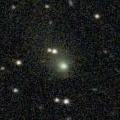
|
It became brighter after the perihelion passage, and it brightened up to 13.4 mag in early 2022 (Jan. 7, Hiroshi Abe). Now it is fading. It has already faded down to 15.9 mag (May 21, Thomas Lehmann). It will be fainter than 18 mag in summer.
Date(TT) R.A. (2000) Decl. Delta r Elong. m1 Best Time(A, h)
June 4 10 23.19 1 6.1 4.065 4.089 84 16.5 20:54 ( 66, 32)
June 11 10 23.22 0 17.8 4.225 4.132 77 16.7 20:59 ( 71, 25)
|

|
It brightened up to 14 mag from 2020 to 2021. Now it is fading slowly. It is observable at 16.5-17 mag in 2022.
Date(TT) R.A. (2000) Decl. Delta r Elong. m1 Best Time(A, h)
June 4 0 25.63 -13 53.4 3.833 3.676 73 16.6 3:02 (294, 9)
June 11 0 31.21 -13 44.1 3.757 3.694 78 16.6 2:59 (296, 12)
|

|
It brightened up to 14 mag in 2021. Now it is fading. It has already faded down to 16.3 mag (May 21, Thomas Lehmann). It is observable at 16-17 mag in 2022.
Date(TT) R.A. (2000) Decl. Delta r Elong. m1 Best Time(A, h)
June 4 0 9.47 7 20.5 5.884 5.585 68 16.6 3:02 (279, 25)
June 11 0 11.16 8 10.6 5.813 5.620 74 16.6 2:59 (282, 30)
|

|
It brightened up to 8.5 mag from autumn to winter in 2021 (Dec. 2, Toshihiko Ikemura, Hirohisa Sato). Now it is fading. It has already faded down to 15.9 mag (May 4, Catalina Sky Survey). It stays observable in good condition for a long time.
Date(TT) R.A. (2000) Decl. Delta r Elong. m1 Best Time(A, h)
June 4 9 59.89 15 10.2 2.676 2.583 73 16.6 20:54 ( 83, 36)
June 11 10 9.09 14 11.4 2.813 2.634 69 16.9 20:59 ( 86, 31)
|

|
Now it is 16.6 mag (May 8, C. Bell). It was observed at 15 mag in 2021. Now it is fading. It stays observable at 16-17 mag for a while in 2022.
Date(TT) R.A. (2000) Decl. Delta r Elong. m1 Best Time(A, h)
June 4 18 30.83 26 9.2 4.671 5.322 125 16.7 1:43 ( 0, 81)
June 11 18 26.26 27 14.3 4.673 5.344 126 16.7 1:11 ( 0, 82)
|
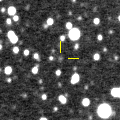
|
Now it is 16.9 mag (May 3, ATLAS Chile). It will brighten up to 13 mag from 2024 to 2025.
Date(TT) R.A. (2000) Decl. Delta r Elong. m1 Best Time(A, h)
June 4 7 33.86 -24 16.8 8.286 7.859 61 16.7 20:54 ( 71,-16)
June 11 7 38.00 -24 6.0 8.305 7.822 58 16.7 20:59 ( 75,-21)
|

|
Now it is 19.5 mag (May 27, Giuseppe Pappa). It is expected to brighten up to 15 mag in autumn, and it will be observable in good condition. But it is fainter than this ephemeris.
Date(TT) R.A. (2000) Decl. Delta r Elong. m1 Best Time(A, h)
June 4 23 55.25 0 23.1 2.447 2.377 74 16.9 3:02 (287, 23)
June 11 0 5.98 1 20.0 2.349 2.355 77 16.8 2:59 (289, 27)
|

|
It brightened up to 14.2 mag in 2021 summer (July 18, 2021, Taras Prystavski). Now it is fading. It has already faded down to 16.2 mag (Jan. 27, SONEAR Observatory, Oliveira). In the Southern Hemisphere, it stays observable in good condition for a long time. In the Northern Hemisphere, it is not observable until July.
Date(TT) R.A. (2000) Decl. Delta r Elong. m1 Best Time(A, h)
June 4 1 58.73 -26 1.2 5.093 4.723 63 16.8 3:02 (291,-16)
June 11 2 3.37 -25 39.1 5.060 4.762 67 16.8 2:59 (293,-12)
|

|
Appearing in the morning sky. It will be observable at 16.5 mag in good condition from summer to autumn.
Date(TT) R.A. (2000) Decl. Delta r Elong. m1 Best Time(A, h)
June 4 1 14.67 12 53.0 2.622 2.137 51 17.0 3:02 (264, 15)
June 11 1 27.89 14 21.4 2.573 2.145 54 17.0 2:59 (265, 18)
|
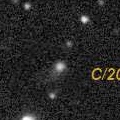
|
Now it is 16.8 mag (May 31, Toshihiko Ikemura, Hirohisa Sato). It stays observable at 17-18 mag for a long time until 2024.
Date(TT) R.A. (2000) Decl. Delta r Elong. m1 Best Time(A, h)
June 4 13 32.70 3 57.3 8.188 8.820 125 17.0 20:54 ( 6, 59)
June 11 13 29.43 4 12.0 8.289 8.819 118 17.0 20:59 ( 23, 57)
|

|
It brightened up to 9.5 mag in early summer in 2021 (June 27, Marco Goiato). Now it is fading. It has already faded down to 17.0 mag (May 7, ATLAS Chile). In the Northern Hemisphere, it stays extremely low.
Date(TT) R.A. (2000) Decl. Delta r Elong. m1 Best Time(A, h)
June 4 23 16.61 -32 43.6 3.910 4.141 95 17.0 3:02 (318, 7)
June 11 23 19.82 -33 21.0 3.876 4.200 101 17.1 2:59 (322, 9)
|

|
Now it is 17.0 mag (May 19, E. Cortes). Fading slowly. In the Northern Hemisphere, it stays observable in good condition for a long time. In the Southern Hemisphere, it is not observable after this.
Date(TT) R.A. (2000) Decl. Delta r Elong. m1 Best Time(A, h)
June 4 18 53.63 66 31.7 9.180 9.200 87 17.2 2:05 (180, 58)
June 11 18 45.67 67 9.7 9.186 9.211 88 17.2 1:29 (180, 58)
|
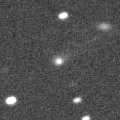
|
Now it is 17.1 mag (May 17, A. Diepvens). It stays 17 mag for a while.
Date(TT) R.A. (2000) Decl. Delta r Elong. m1 Best Time(A, h)
June 4 13 8.29 -7 18.3 4.049 4.710 125 17.2 20:54 ( 13, 47)
June 11 13 8.03 -7 20.8 4.139 4.711 118 17.2 20:59 ( 25, 44)
|
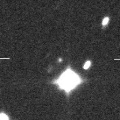
|
Now it is 17.6 mag (May 13, Giuseppe Pappa). It is expected to brighten up to 12.5 mag in winter. It will become unobservable temporarily at 17 mag in July. In the Northern Hemisphere, it will become observable again in October. Then it stays observable in good condition after that. In the Southern Hemisphere, it is not observable at the high light.
Date(TT) R.A. (2000) Decl. Delta r Elong. m1 Best Time(A, h)
June 4 10 27.00 6 42.1 3.531 3.552 82 17.2 20:54 ( 70, 36)
June 11 10 27.60 7 46.6 3.591 3.487 75 17.2 20:59 ( 77, 31)
|

|
Now it is 17.8 mag (Apr. 22, ATLAS Chile). It stays 17 mag for a long time from 2021 to 2022. In the Southern Hemisphere, it stays observable in good condition for a long time. It is not observable in the Northern Hemisphere.
Date(TT) R.A. (2000) Decl. Delta r Elong. m1 Best Time(A, h)
June 4 6 50.46 -40 59.6 5.809 5.537 69 17.4 20:54 ( 59,-32)
June 11 6 53.65 -41 7.5 5.850 5.552 68 17.4 20:59 ( 61,-37)
|

|
It will brighten up to 16.5 mag in July. In 2022, it stays observable for a long time.
Date(TT) R.A. (2000) Decl. Delta r Elong. m1 Best Time(A, h)
June 4 21 38.79 -12 36.0 0.722 1.435 110 17.7 3:02 (327, 36)
June 11 22 3.58 -9 50.3 0.640 1.375 110 17.4 2:59 (325, 38)
|

|
Now it is 17.9 mag (May 18, Yasukazu Ikari). It is observable at 17 mag from spring to summer. In the Northern Hemisphere, it becomes low in summer.
Date(TT) R.A. (2000) Decl. Delta r Elong. m1 Best Time(A, h)
June 4 11 24.78 17 16.2 1.788 2.085 91 17.5 20:54 ( 69, 54)
June 11 11 30.89 14 46.3 1.847 2.072 87 17.5 20:59 ( 72, 47)
|

|
Now it is 17.6 mag (May 3, ATLAS Chile). It will brighten up to 16 mag in 2023. In the Southern Hemisphere, it stays observable in good condition for a long time. In the Northern Hemisphere, it will be unobservable soon.
Date(TT) R.A. (2000) Decl. Delta r Elong. m1 Best Time(A, h)
June 4 9 41.54 -17 9.4 4.019 4.010 82 17.6 20:54 ( 59, 12)
June 11 9 44.80 -17 30.6 4.071 3.973 77 17.5 20:59 ( 63, 7)
|
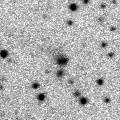
|
Now it is 16.9 mag (May 18, Masayoshi Yoshimi). It started fading before the perihelion passage. It was predicted to stay at 16 mag for a long time. But actually, it will be fainter than 18 mag in autumn. In the Northern Hemisphere, it stays observable in good condition for a long time. In the Southern Hemisphere, it is not observable until 2023.
Date(TT) R.A. (2000) Decl. Delta r Elong. m1 Best Time(A, h)
June 4 23 50.76 81 31.4 4.075 3.770 65 17.6 3:02 (189, 39)
June 11 23 24.88 82 39.2 4.058 3.776 66 17.6 2:59 (187, 40)
|
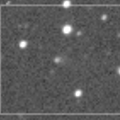
|
It was observed at 17 mag in 2021. It is observable at 17-18 mag also in 2022. It will be observable soon also in the Northern Hemisphere.
Date(TT) R.A. (2000) Decl. Delta r Elong. m1 Best Time(A, h)
June 4 2 7.63 -0 42.7 3.891 3.255 45 17.6 3:02 (268, -4)
June 11 2 14.72 0 26.6 3.839 3.269 49 17.6 2:59 (270, 0)
|

|
Now it is 17.2 mag (May 10, Hirohisa Sato). It stays 17-18 mag until June.
Date(TT) R.A. (2000) Decl. Delta r Elong. m1 Best Time(A, h)
June 4 20 3.18 -12 59.1 1.283 2.105 132 17.8 3:02 (355, 42)
June 11 19 36.00 -9 19.3 1.259 2.162 143 17.8 2:22 ( 0, 46)
|

|
It brightened up to 14.2 mag from summer to autumn in 2021 (Sept. 3, C. S. Morris). Now it is 17.7 mag (May 18, Catalina Sky Survey). Fading slowly. In the Northern Hemisphere, it is observable in good condition. It is not observable in the Southern Hemisphere.
Date(TT) R.A. (2000) Decl. Delta r Elong. m1 Best Time(A, h)
June 4 14 38.96 69 21.9 7.137 7.128 85 17.8 21:46 (180, 56)
June 11 14 26.54 68 51.0 7.217 7.167 83 17.8 21:06 (180, 56)
|

|
Now it is 18.1 mag (May 18, Catalina Sky Survey). It stayed 17.5 mag for a long time in 2021. It will be fading slowly after this. In the Northern Hemisphere, it is observable in good condition. It is not observable in the Southern Hemisphere.
Date(TT) R.A. (2000) Decl. Delta r Elong. m1 Best Time(A, h)
June 4 11 33.07 62 32.5 7.509 7.320 75 17.8 20:54 (153, 56)
June 11 11 33.92 61 22.2 7.586 7.337 72 17.8 20:59 (148, 53)
|

|
Now it is 17.4 mag (May 18, iTelescope Observatory, Siding Spring). It is expected to brighten up to 12-13 mag from 2024 to 2025.
Date(TT) R.A. (2000) Decl. Delta r Elong. m1 Best Time(A, h)
June 4 9 52.71 -21 28.5 7.735 7.739 86 17.8 20:54 ( 54, 11)
June 11 9 53.06 -20 49.0 7.796 7.695 80 17.8 20:59 ( 59, 6)
|
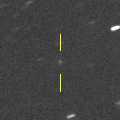
|
Now it is 17.8 mag (Mar. 8, D. Buczynski). The condition is bad in this apparition. It will brighten up to 13 mag in winter. But it is not observable at the high light. Before the perihelion passage, it is observable only until August when it brightens up to 17 mag.
Date(TT) R.A. (2000) Decl. Delta r Elong. m1 Best Time(A, h)
June 4 10 13.39 20 10.7 2.606 2.543 75 17.9 20:54 ( 87, 41)
June 11 10 20.38 19 7.7 2.655 2.504 70 17.8 20:59 ( 89, 36)
|

|
It was observed at 16 mag from 2020 to 2021. Now it is fading. It will be fainter than 18 mag in summer.
Date(TT) R.A. (2000) Decl. Delta r Elong. m1 Best Time(A, h)
June 4 22 25.60 15 9.3 6.691 6.750 88 17.9 3:02 (289, 50)
June 11 22 24.13 14 59.3 6.599 6.772 95 17.9 2:59 (296, 55)
|

|
Now it is 17.8 mag (May 31, Toshihiko Ikemura, Hirohisa Sato). It will be fading after this, and it will be fainter than 18 mag in June.
Date(TT) R.A. (2000) Decl. Delta r Elong. m1 Best Time(A, h)
June 4 11 42.69 9 57.9 2.236 2.595 98 17.9 20:54 ( 55, 52)
June 11 11 48.83 9 3.2 2.351 2.625 94 18.1 20:59 ( 61, 47)
|

|
Now it is 17.3 mag (May 5, ATLAS Chile). Very far object. It stays 18 mag for a long time from 2021 to 2026. In the Southern Hemisphere, it stays observable in good condition for a long time. In the Northern Hemisphere, it is not observable at all.
Date(TT) R.A. (2000) Decl. Delta r Elong. m1 Best Time(A, h)
June 4 7 32.43 -62 24.9 10.628 10.693 90 17.9 20:54 ( 33,-32)
June 11 7 34.88 -62 12.4 10.641 10.683 89 17.9 20:59 ( 34,-35)
|

|
Now it is 17.9 mag (May 11, Giuseppe Pappa). It was expected to be observable at 16 mag in good condition in spring. But actually, it is fainter than predicted by 2-3 mag.
Date(TT) R.A. (2000) Decl. Delta r Elong. m1 Best Time(A, h)
June 4 21 17.87 -1 23.6 0.933 1.606 110 18.4 3:02 (326, 48)
June 11 21 20.51 1 14.6 0.921 1.640 115 18.5 2:59 (332, 53)
|
|
![]()
 29P/Schwassmann-Wachmann 1
29P/Schwassmann-Wachmann 1 C/2022 E3 ( ZTF )
C/2022 E3 ( ZTF ) 73P/Schwassmann-Wachmann 3
73P/Schwassmann-Wachmann 3 C/2020 Y2 ( ATLAS )
C/2020 Y2 ( ATLAS ) C/2018 U1 ( Lemmon )
C/2018 U1 ( Lemmon ) 81P/Wild 2
81P/Wild 2 C/2021 O3 ( PanSTARRS )
C/2021 O3 ( PanSTARRS ) C/2020 J1 ( SONEAR )
C/2020 J1 ( SONEAR ) (3200) Phaethon
(3200) Phaethon 104P/Kowal 2
104P/Kowal 2 C/2020 H6 ( ATLAS )
C/2020 H6 ( ATLAS ) 152P/Helin-Lawrence
152P/Helin-Lawrence C/2020 M5 ( ATLAS )
C/2020 M5 ( ATLAS ) 246P/NEAT
246P/NEAT C/2020 F5 ( MASTER )
C/2020 F5 ( MASTER ) 67P/Churyumov-Gerasimenko
67P/Churyumov-Gerasimenko C/2020 O2 ( Amaral )
C/2020 O2 ( Amaral ) C/2021 G2 ( ATLAS )
C/2021 G2 ( ATLAS ) 61P/Shajn-Schaldach
61P/Shajn-Schaldach C/2019 F1 ( ATLAS-Africano )
C/2019 F1 ( ATLAS-Africano ) 44P/Reinmuth 2
44P/Reinmuth 2 C/2020 F2 ( ATLAS )
C/2020 F2 ( ATLAS ) C/2020 T2 ( Palomar )
C/2020 T2 ( Palomar ) C/2019 O3 ( Palomar )
C/2019 O3 ( Palomar ) 99P/Kowal 1
99P/Kowal 1 C/2022 A2 ( PanSTARRS )
C/2022 A2 ( PanSTARRS ) C/2020 F7 ( Lemmon )
C/2020 F7 ( Lemmon ) 107P/(4015) Wilson-Harrington
107P/(4015) Wilson-Harrington 100P/Hartley 1
100P/Hartley 1 C/2021 C5 ( PanSTARRS )
C/2021 C5 ( PanSTARRS ) C/2020 U5 ( PanSTARRS )
C/2020 U5 ( PanSTARRS ) 422P/2021 L1 ( Christensen )
422P/2021 L1 ( Christensen ) C/2022 J1 ( Maury-Attard )
C/2022 J1 ( Maury-Attard ) C/2019 K7 ( Smith )
C/2019 K7 ( Smith ) C/2020 P3 ( ATLAS )
C/2020 P3 ( ATLAS ) C/2022 E2 ( ATLAS )
C/2022 E2 ( ATLAS ) 71P/Clark
71P/Clark C/2019 T3 ( ATLAS )
C/2019 T3 ( ATLAS ) 70P/Kojima
70P/Kojima C/2019 E3 ( ATLAS )
C/2019 E3 ( ATLAS ) 325P/Yang-Gao
325P/Yang-Gao![]()




















































